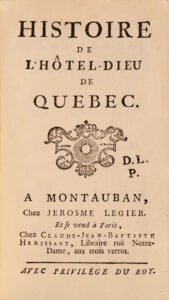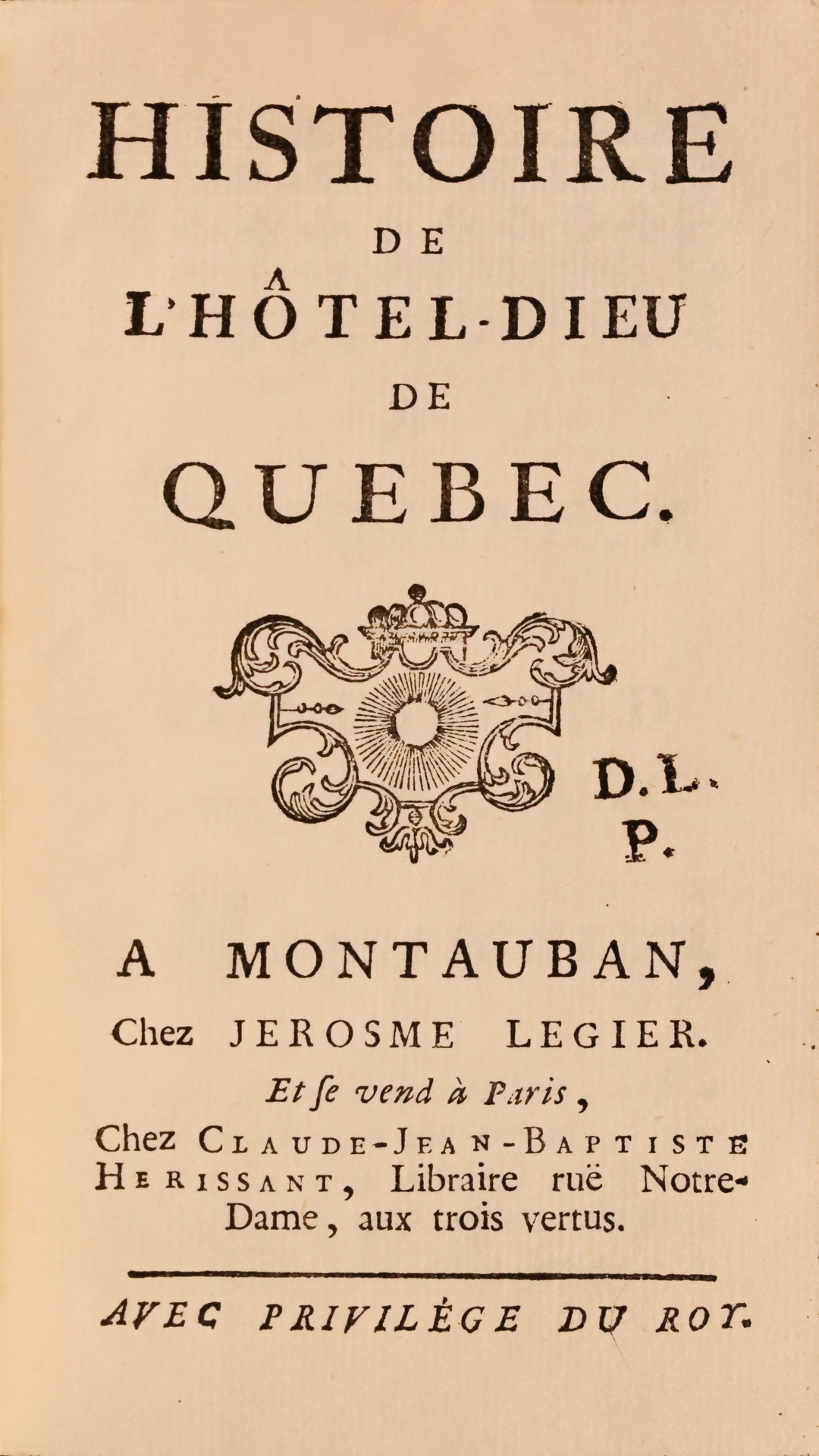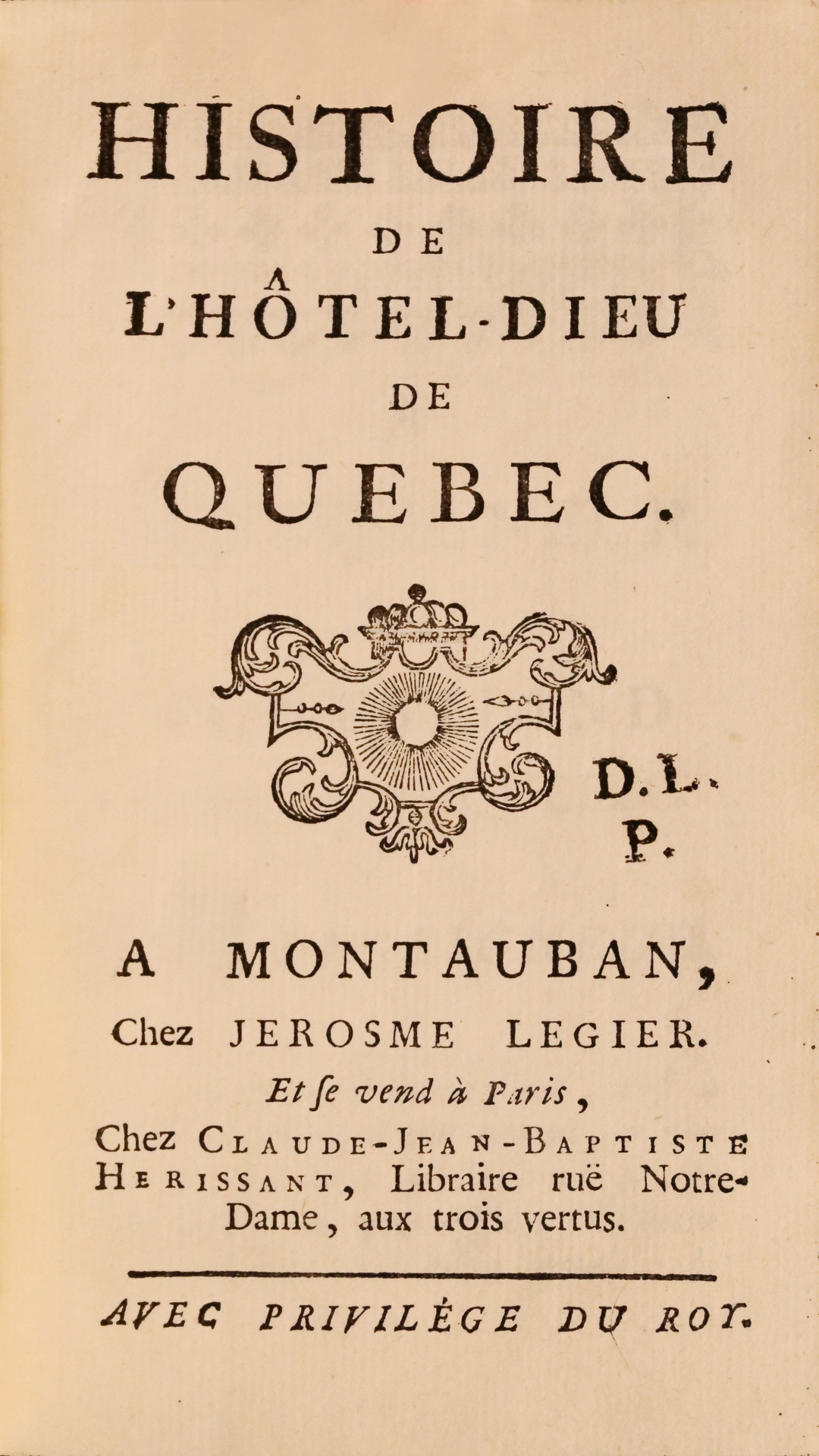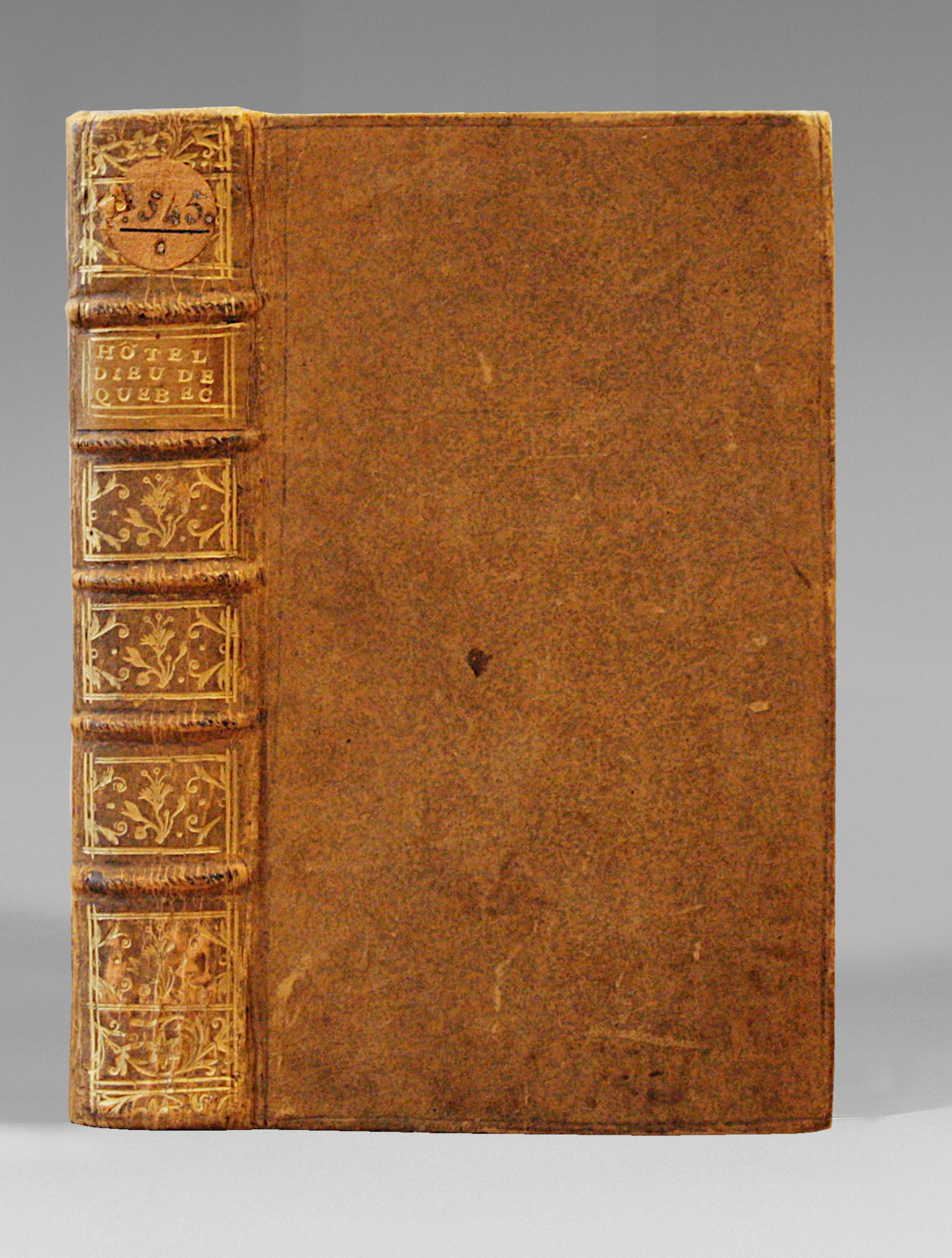Montauban, chez Jerosme Legier, et se vend à Paris, chez Claide-Jean-Baptiste Herissant, n.d. [1752].
12mo [162 x 91 mm] of (8) ll., 556 pp., (1) l. Brown calf, blind-stamped fillet around the covers, spine ribbed with gilt fleurons, mottled edges. Contemporary binding.
The first edition of these annals recounting the creation in Quebec City of the first hospital by the Hospitallers of Dieppe under the auspices of the Duchess of Aiguillon, niece of the cardinal de Richelieu.
Barbier, II, 686.
Driven out of New France after the fall of Quebec to the Kirke brothers in 1629, the Jesuits went back there three years later after the Treaty of Saint-Germain-en-Laye (1632) gave France back its colony and, for a time, “the Canadian Church will be missionary”, with Father Paul Le Jeune at its head. It was him who, in 1634, expressed the need for a hospital to care for the natives and the few settlers there.
It was with the Natives in mind that Father Le Jeune asked for hospital nuns to come to Quebec City.
“The mystical impulse that swept through France in the first decades of the seventeenth century coincided with the colonizing movement,” and it is not surprising that several nuns from orders and monasteries showed a keen interest in the Jesuit’s project. However, the material conditions for the establishment of nuns and a monastery-hospital in Quebec City were virtually non-existent. Father Le Jeune therefore launched a new appeal, but this time he addressed himself to people “capable of supporting the enterprise financially”. The answer came from the French court.
The Duchess of Aiguillon, married at 16 to the Marquis of Combalet, according to the wishes of her uncle, the Cardinal of Richelieu, became a widow at 18; she did not remarry and used almost all of her fortune to relieve the poor and to found charitable institutions. At only 31, she was already very committed to these ends. In particular, she was the main founder of the great hospital of Paris, according to the historian Henri-Raymond Casgrain.
Under the spiritual guidance of St. Vincent de Paul, promoter and initiator of numerous works of charity, and marked by her reading of the Jesuit Relations, particularly the 1635 one by Father Le Jeune, the duchess became aware of the importance of the Canadian missions in the history of the Church.
In 1636, the Duchess of Aiguillon “resolved to found a Hôtel-Dieu at her own expense.” To carry out this ambitious project, she chose to call upon the Religious Hospitallers of the Order of Saint-Augustin, then known as the Daughters of Mercy, who were living in the monastery of Dieppe. “The Cardinal of Richelieu, her uncle, wanted to enter into the good work, & until their death they both had a singular affection for this house, they gave fifteen hundred pounds of income to the capital of 20,000 pounds to be taken from the coaches and carriages of Soissons which belonged to them, the contract was signed on 16 August 1637.
Dr Yves Morin describes the “junction of four factors” that led the Duchess to carry out her work: “(…) the Duchess’s spirit of charity, her influence at the court through her uncle, the Cardinal Richelieu, her knowledge of New France thanks to the Jesuits, and the essential role of the Hôtel-Dieu de Dieppe, one of the pre-eminent establishments in France.”
In April 1639, King Louis XIII granted patent letters for the establishment of the hospital and explicitly mentioned the religious motives of the duchess. There was also a second contract in 1640 in which these same motives were stated. In her letter to Marie Guenet de Saint-Ignace, the first superior of the Hôtel-Dieu de Québec, the day before the departure of the three Augustinian nuns for Quebec City, the Duchess d’Aiguillon clearly wrote that the Hôtel-Dieu was to be “dedicated to the death and precious Blood of the Son of God shed to show mercy to all men and to ask him to apply it to the soul of Monseigneur le Cardinal Duc de Richelieu, and that of Madam the duchess of Aiguillon and for all this poor people…”.
The Duchess obtained from the Compagnie des Cent-Associés a concession of seven acres in the enclosure where they had begun to build Quebec and a fief of sixty acres in the suburbs, between Cap-Rouge and the Sainte-Geneviève hill, the land that had been designated under the name of Sainte-Marie.
Mothers Anne Le Cointre of Saint-Bernard (28 years old), Marie Forestier of Saint-Bonaventure-de-Jésus (22 years old) and Marie Guenet of Saint-Ignace (29 years old), who was to become the first superior of the Hôtel-Dieu de Québec, left their families and friends, and their monastery in Dieppe, established since 1285, on May 4, 1639, headed for Québec.
“From 1739 to 1779, Latour published an imposing sum of sermons, panegyrics, dogmatic discourses, liturgical and canonical memoirs and others. When he left Canada, he took with him a manuscript copy of the ‘Annales de l’Hôtel-Dieu de Québec’ written by Jeanne-Françoise Juchereau de La Ferté, known as Saint-Ignace. He published this text in 1752 in Montauban, under the title ‘Histoire de l’Hôtel-Dieu de Québec’.”
“In his bibliographical notes on the sources of his own “Histoire de l’Hôtel-Dieu de Québec”, Montreal, ed. C. O. Beauchemin & Fils, volume 4, p. 11, the historian Henri-Raymond Casgrain writes about the “Histoire de l’Hotel-Dieu de Québec”, by Mother Juchereau of Saint-Ignace: “This History was written according to the information of the mother (Marie Guenet) of Saint-Ignace and written by the mother of Saint-Hélène. A copy of these annals having been given to Mr. de La Tour, dean of the chapter of Quebec, who returned to France in 1731, he took it upon himself to have them printed without the knowledge of the community of Quebec. This printing was done without much care, and a large number of typographical errors have crept into the work. Fortunately, the Hôtel-Dieu still has the original copy in the hand of the mother (Marie-André Duplessis) of Sainte-Hélène, and signed by Mother Jeanne-Françoise Juchereau of Saint-Ignace. These annals are one of the most precious historical documents we possess.” Jeanne-Françoise Jucheron’s text was reprinted in Quebec City by Dom Albert Jamet in 1939 under the title “Annales de l’Hôtel-Dieu de Québec, 1636-1716”.
A precious copy of this rare canadiana preserved in its contemporary binding.




